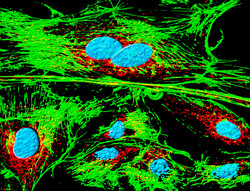Cytoskeleton component crosstalk
Cells maintain their structure and morphology through the cytoskeleton, a dynamic scaffold that consists of microtubules and actin filaments. In addition, these structures govern cell migration, adhesion and division. Recent evidence indicates that microtubules and actin filaments cooperate functionally during many of these processes through the activity of specific linker molecules. The aim of the EU-funded CYTOSKELETONCOUPLING (Active actin-microtubule crosstalk in reconstituted systems) project was to obtain a detailed understanding of the effects of linker molecules on actin-microtubule co-organisation. For this purpose, scientists developed an in vitro model system where microtubules grew from centrosomes on coverslips within a network of actin filaments. To couple the two components, they used the TipAct linker molecule, which is similar in functionality to the protein MACF. They observed that the linker allowed the growing microtubules to steer actin bundle formation and to transport actin filaments. Microtubules were sensitive to the presence of dense actin networks and, at the same time, actin bundles reliably captured and guided growing microtubules. This phenomenon was independent of biochemical regulation and occurred under a wide spectrum of different geometrical and mechanical settings. Furthermore, the research team investigated microtubule behaviour in the presence or absence of obstacles. Using fluorescence microscopy techniques they followed the dynamics of individual growing microtubules in vitro and combined the data with stochastic computer simulation models of the cytoskeleton. Apart from fundamental knowledge into the mechanism of cytoskeleton component crosstalk, CYTOSKELETONCOUPLING findings provide unprecedented insight into the regulation of key cellular processes.



